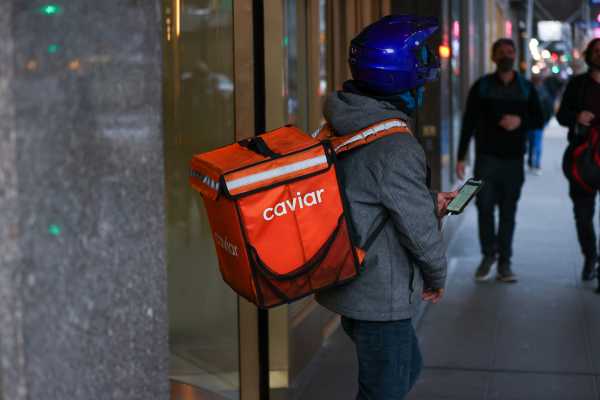
The Biden administration has released a long-awaited proposal that could make it easier for millions of truckers, Uber drivers, freelance writers, home care workers, and janitors to be classified as employees rather than independent contractors — a shift that would grant them access to a host of federal labor protections.
The Biden administration’s 184-page proposed rule would change how the federal agency determines who constitutes an employee or an independent contractor under the Fair Labor Standards Act, the 1938 law that determines eligibility for protections like minimum wage, overtime, Social Security, and unemployment insurance.
It’s the latest development in a legal back-and-forth between presidential administrations that stretches back more than a decade. If the rule is finalized, it will almost certainly be challenged in court.
The rule could have ramifications for the so-called gig economy. Companies like Uber, Lyft, and Instacart have argued that classifying their drivers as employees rather than contractors would devastate their business models. Other self-employed workers defend their independent contractor status, and say they prefer the flexibility and autonomy they’re afforded as they seek to balance other priorities in their lives.
If the Biden administration’s proposed rule goes into effect — a big if — it could have significant consequences for workers and businesses alike.
In the waning days of the Trump administration, the Labor Department finalized a new rule that gave extra weight to two specific questions when determining if someone is an independent contractor: how much control does a worker have over their work — can they set their own schedule, work for multiple employers, and reject certain projects? And how great is a worker’s opportunity for profit or loss based on their own initiative or investment? One tenet of independent contracting is that there should be “entrepreneurial opportunity” built into the arrangement.
Organized labor has long held that this sort of employee classification test is too narrow, and that a broader “multi-factorial” test should be used to ensure higher working standards for as many people as possible. Union activists say a better test would give roughly equal weight to at least seven factors, including how important the worker is for the employer’s business, and how long the worker is employed.
The Biden administration agrees. It wrote in its new proposal that it sees reverting back to this broader test as “more consistent with existing judicial precedent and the Department’s longstanding guidance prior” to the 2021 Trump rule.
Rondu Gantt, an Uber, Lyft, and DoorDash driver based in San Francisco who organizes with the campaign Gig Workers Rising, said in a statement, “This rule can help establish bedrock protections for app-based workers like me and give us an important tool to fight for respect and safety on the job. Gig workers deserve all of the rights that other employees have, including the right to organize. This rule can also help protect workers all around the country as gig corporations try to bring their abusive model to the rest of the economy.”
Federal courts have rejected past attempts to make the independent contracting rule more worker-friendly
The lines between contracting and employment have been blurring in the age of remote work, but in general, it’s about how much control an employer exerts over an individual performing work for them, and what legal entitlements a worker can expect as a result. One major legal entitlement employees enjoy is the right to join a union. Another is the right to be paid at least the minimum wage, and for businesses to pay a portion of their Social Security tax. Contractors have no such guarantees, but some prefer the flexibility, and say they’d trade the workplace protections for freedom from a boss.
The federal government has not made adjudicating this debate simple. In 1947, Congress explicitly carved out independent contractors from the National Labor Relations Act’s definition of “employee.”
In 1968, the Supreme Court ruled in its United Insurance decision that the “obvious purpose” of Congress excluding independent contractors from the law was to have the NLRB and courts “apply the common-law agency test” when distinguishing an employee from an independent contractor. Since then, the board and courts have used a 10-factor test to settle the question. Much of the legal debate over the last 15 years has been over whether any of those 10 factors — particularly entrepreneurial opportunity — should weigh more heavily than others.
In 2006, FedEx Home Delivery drivers in Massachusetts sought to unionize with the Teamsters, but after they won their union election, FedEx refused to bargain with the drivers, saying they were independent contractors. The National Labor Relations Board sided with the drivers in 2007, but two years later, the US Court of Appeals for the DC Circuit overturned the NLRB’s decision, pointing to the drivers’ “entrepreneurial potential” — meaning their ability to shape both their work conditions for FedEx and additional clients — as a decisive factor. The appellate judges wrote in their decision that the NLRB “has no authority whatsoever over independent contractors.”
The NLRB chose not to appeal this to the Supreme Court, the only US court whose rulings the NLRB considers as binding. So when a similar case came back up a half-decade later, the NLRB sided with FedEx drivers again. (This case involved Hartford, Connecticut, drivers who unionized.)
Three years later, in 2017, the DC Circuit rejected the NLRB’s ruling once again, and pointed back to its 2009 decision when it said, “The question before this court was already asked and answered.”
As all this was going on, businesses like Uber that rely heavily on independent contracting continued to expand, and began to look at currying favor with sympathetic politicians who could help codify their legally vulnerable business models. Corporate executives kept a wary eye on the legal battles unfolding in Washington, DC, but few felt real pressure to change their practices amid the uncertainty.
By January 2019, the NLRB, which at this point had a Republican-appointee majority on its five-member panel, formally overturned its 2014 FedEx decision, in a case where a regional NLRB office had found that shuttle drivers who owned and operated franchises of SuperShuttle DFW were independent contractors. This 2019 SuperShuttle decision effectively reverted society back to the old gig economy-friendly independent contractor standard.
Biden’s team has hinted it would be revisiting the misclassification issue
The Biden administration has been building toward action on this issue for years.
Biden’s presidential campaign emphasized supporting and standing with labor unions, and the week of his inauguration he forced out two Trump-appointed NLRB counsels, the first time in more than 70 years a president exercised that power. He then appointed Democrat Lauren McFerran, the lone dissenter in the 2019 SuperShuttle decision, to serve as NLRB board chair, and his administration blocked the Trump independent contractor rule from taking effect.
Biden also nominated Jennifer Abruzzo, a lawyer with the Communications Workers of America, to serve as the NLRB’s general counsel. By August 2021 Abruzzo had issued a 10-page memo laying out her priorities and instructed the agency’s regional offices to prioritize cases that pertain to specific past decisions, including the 2019 SuperShuttle case.
In late December, the National Labor Relations Board announced it would be accepting briefs relating to whether the federal agency should reconsider its standard — again — for determining independent contractor status.
The fierce debate over contracting and the global economy
When the NLRB issued its request for briefs in late December, it asked two main questions: Should the board stick to the independent contractor standard it established in its 2019 SuperShuttle decision? And if not, then what standard should replace it: should the NLRB return to its 2014 standard set by the more union-friendly FedEx Home Delivery decision?
Public interest, government, and industry groups submitted more than 30 amicus briefs and were far from unanimous. While many of the same arguments were recycled from the FedEx and SuperShuttle cases, briefs also featured some new themes, like that misclassification of workers poses an antitrust threat. One brief, filed by the Department of Justice’s antitrust division, argued that “a vague or under-inclusive” employee standard could harm workers, employers, and competition directly.
The Labor Department rule is technically separate from the NLRB request for documents, though it centers on very similar legal questions. Before Tuesday, the Labor Department says, its wage and hour division considered feedback shared by stakeholders in forums held during the summer of 2022.
“Standards and definitions under both statutes are a little different, but it’s definitely the same fruit salad and the two pieces of fruit are right next to each other,” said Michael Lotito, a management-side labor attorney at the law firm Littler Mendelson.
AFL-CIO President Liz Shuler hailed the draft rule on Tuesday for “restoring commonsense rules to determine who is an employee, and making it harder for employers to intentionally misclassify their employees as independent contractors.” In the organization’s filed briefs to the NLRB, it warned against trying to revert back to a standard that couldn’t survive the courts.
An NLRB brief filed by Democratic attorneys general representing 15 states and Washington, DC, argued that the “entrepreneurial opportunity” standard privileged by SuperShuttle is “particularly vulnerable to evasion” by employers.
They urged instead weighting the three factors that form the basis for the so-called “ABC” tests used by many states to determine employee status, a test that makes it harder to classify someone as a contractor. A worker is only considered a contractor under this test if they have relative independence from the business paying their wages, if their work is separate from the type of work the business is typically engaged in, and if they typically do the type of work that the business hired them to do. In particular, “entrepreneurial opportunity” is insufficient to merit contractor status under the ABC test.
Some groups had urged the NLRB to find a new middle-ground position.
Buckle, a digital financial services company that provides insurance and credit options to drivers for ride-share and other gig companies, said the NLRB “should not be afraid to set a precedent allowing both employees and independent contractors.” For example, they said, their data indicates that 80 to 90 percent of drivers on gig platforms work less than 20 hours a week. But for the 10 to 20 percent who drive 20 hours or more per week, and who “are heavily relied upon” by the companies to maintain consistent service levels, there should be clearer pathways to distinguish between them and the more casual workers.
Other groups pushed the Biden administration to adhere to the status quo. One brief representing 12 Republican senators and another brief representing 30 Republican representatives pointed out that the Democratic-backed Protecting Right to Organize Act, which would make it harder to classify workers as independent contractors, failed to pass in the Senate. “Congressional opposition to the change is, in part, because many Members believe that the current approach is best adapted to a twenty-first century economy,” the GOP officials wrote.
The US Chamber of Commerce, the largest business lobby, also warned of government overreach. There is no reason for the NLRB to depart from its SuperShuttle standard, the Chamber wrote in its brief, and to do so “is a plain instance of its policy reach far exceeding its legitimate regulatory grasp.”
Some groups representing freelancers and small businesses also urged the NLRB against revising its contracting standard, worried they would lose their prized independent status. They pointed to government surveys, like a 2015 GAO report that found more than 85 percent of independent contractors and those self-employed appeared content with their status. In 2018, the Bureau of Labor Statistics reported 79 percent of independent contractors preferred their contracting arrangement over a traditional job.
The Small Business and Entrepreneurship Council issued a statement on Tuesday calling the Labor Department’s rule “out-of-touch with the modern economy and how people want to work.”
Given this opposition, a court challenge to the rule seems inevitable. Lotito, the labor lawyer, told Vox he thinks the Biden administration’s new rule will fail in court, and pointed to his firm’s successful challenge against the Biden administration’s withdrawal of Trump’s worker classification rule. “My overall sense is that they really did not pay any attention to the [Texas] District Court’s decision; there’s no explanation that I’ve read so far that explains how the Trump rule has interfered with their ability to enforce their mission,” he said. “From an Administrative Procedure Act perspective, I also think this is a straight flop.”
However, no legal challenge can be mounted against the rule until it is finalized. The Department of Labor is currently soliciting public comments on its proposal, and the final rule will likely not be issued for another few months.
Our goal this month
Now is not the time for paywalls. Now is the time to point out what’s hidden in plain sight (for instance, the hundreds of election deniers on ballots across the country), clearly explain the answers to voters’ questions, and give people the tools they need to be active participants in America’s democracy. Reader gifts help keep our well-sourced, research-driven explanatory journalism free for everyone. By the end of September, we’re aiming to add 5,000 new financial contributors to our community of Vox supporters. Will you help us reach our goal by making a gift today?
Sourse: vox.com






